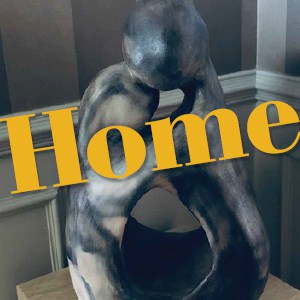In some homes, art sits center stage, which is why we’ve made it the focus of this section.
Elyse and David Cardon’s Virginia Beach home, for example, is all about expression—art, fun, function, music, entertainment, and love.
Artists Jodie Frieden, Abbie Korman, Ivor Kaplan, and David Cardon fill their homes with their work, some of which is showcased on pages 20 and 21. One of Jodie Frieden’s pieces is this section’s cover.
Of course, there’s more to most homes than art…security, mortgages, and recipes are all important and crucial ingredients. You’ll find articles about each within these pages.
After reading this issue, perhaps you’ll be inspired to take an art class or change your password or bake a cake or improve just a portion of your living space. Or, not.
Thanks for reading,
Terri Denison
Editor
Cardon 6: Creativity, uninterrupted
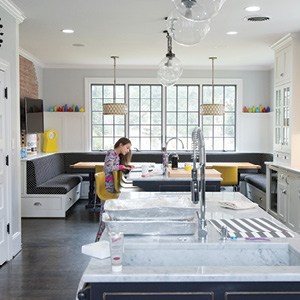
Sylvie Cardon studies in the kitchen.
“My life is a journey of blessings. I am always growing through open-minded, whole-hearted living and am grateful to have the freedom to express love without fear.”
—Elyse Tapper Cardon
Elyse and David Cardon’s home life is a visual reflection of their love of each other and their love of artistic freedom. They’ve created spaces in their home for both intimate and large gatherings, as well as for flow of creative expression.
“I need lots of light and sacred spaces to allow, not only myself, but my entire family to surrender to the moment—to experience whatever form of expression one needs that day—be it music or song, visual art, writing, or meditation and prayer. It could be a corner of a room with twinkle lights or a special spot under a tree. If it sounds a bit whimsical, then I’ve achieved my design goal,” Elyse says.
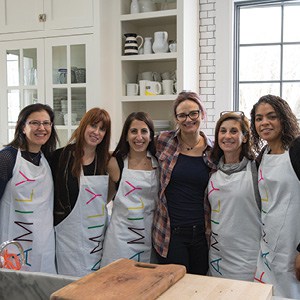
Hosts of a Bat Mitzvah brunch in the Cardons’ kitchen: Jan Konikoff, Stacie Caplan, Rachel Abrams, Elyse Tapper Cardon, Alicia Friedman, and Ashley Zittrain.
The Cardon’s unique home, affectionately nicknamed ‘Chez Cardon,’ by friends, is one of the few remaining historic houses in Virginia Beach (circa 1885), and the Cardons are only the fourth owners. When they bought this gem 12 years ago, the cozy 50’s-style kitchen had a faded black and white checkered linoleum floor, a tiny, single oven (it could not even fit a regular sized cookie sheet), and red-painted cabinetry with stainless steel counters. It was only a matter of time before the Cardons would transform the space into their dream kitchen. Taking notice time and time again, that no matter the size and space of the house, people tended to gravitate to the kitchen, making an expansion was in order. Three years later, the kitchen was gutted and nearly doubled in size.
“The U-shaped banquette, surrounded by windows, with two separate tables rather than one, allows us to have flexible seating options. We’ve had up to 14 people comfortably gather at one time,” says David. The Cardons recycled the kitchen cabinets in another room and feel strongly about preserving the original elements. “Our home is a synthesis between old and new,” says David.
“My desire is to bring this house into the next century of her life, adorning her with modern art and modern efficiencies, all while being true to her classic, timeless charm,” adds Elyse.
Elyse’s signature eclectic style aligns with the diverse roles she’s played so far in life. She is a wife of 20 years, a mother of four (Bella, Sylvie, Avi and Flora), a professional dancer, teacher, Pilates instructor, professional photographer, writer, entrepreneur and community activist—and who knows what’s next…. “So I guess that makes me an artist…. I love the freedom of mixing it up, creating a vibe of modern life infused with history and tradition. It shows up in my fashion choices, my home and even my mix of friends.”
“I truly wake up every day and am awed at what I see in nature,” says Elyse. “Some days feel bold like neon, some serene pastel and some black, white and gray. One is not better than the other to me. My wish is for everyone to see what I see, but of course, in their own way. I feel so much gratitude when I open my eyes every morning, and I’ve learned to embrace my free-spirit to meet each new day with curiosity.”
David, an attorney of 23 years, has always considered himself an artist and musician. He was a fine-arts minor in college and much of his pottery is on display at his office.
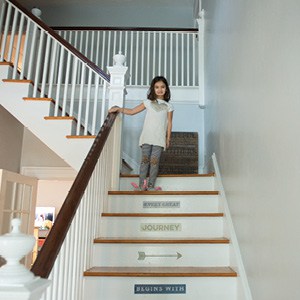 “We both applaud our kids’ creativity,” says David.
“We both applaud our kids’ creativity,” says David.
“Just last week, Sylvie (13) wanted to decorate some plastic storage boxes and after discussing what type of marker to use, we encouraged her to do it. We know that might not be the norm,” says Elyse.
Elyse feels being Jewish and an artist just go together. “The Jewish people as a whole seem to appreciate and lean into the fact that freedom of expression and creativity is a necessity—a part of life corresponding to Jewish values.”
She often journals about our divine creativity. “I believe everyone is a creative soul. One does not need an easel to be creative. I hear so many say they don’t have a creative bone in their body. Many people have a stigma around that word. Every time I hear this, I know that they are likely uncomfortable connecting to their higher self. I try to point out all the ways they are creative already.”
Love struck Elyse and David more than 20 years ago when Elyse was in Virginia Beach for a temporary visit. It was a time when her father F. Bruce Tapper’s (of blessed memory) sudden death was still very raw.
David, a then young attorney, stopped to say hello to Elyse’s mother Susan Tapper, the long-time librarian at Hebrew Academy of Tidewater on Thompkins Lane. He was attending a meeting at HAT as co-chair of UJFT’s Super Sunday Campaign. David and Elyse are both HAT alum, one year apart.
Wanting to reconnect with his old schoolmate Elyse, David asked Susan for Elyse’s number. Initially, Susan deflected his request, following strict orders from her single daughter NOT to give her phone number to anyone, ‘because of all the yentas in town trying to hook up a single female in her 20s with any single Jewish male that stepped foot in Hampton Roads.’
David persisted. Motion granted.
“I heard his voice on the phone saying who he was and inquiring how I was doing,” says Elyse. “I can honestly say, he had me at a “hello!”” It wasn’t long before they went on their first date, and the rest is history.
In addition to current creative pursuits in the dance community, Elyse volunteers on the Holocaust Commission, serves on the board of the Benjamin Goldberg Foundation and is chair of the Hampton Roads Advisory Council for the Richmond Ballet/State Ballet of Virginia. David has his own law practice, Cardon Law, and serves on the board of Strelitz International Academy as president-elect. He also sings in the Beth El Congregation choir and plays guitar at Beth El’s Shabbat unplugged. The Cardons were among the four founding members of Tidewater Couples Project.
Nathan Segal, now married to Elyse’s mother Susan Tapper Segal, says, “Elyse embraces the best of new trends and incorporates them effortlessly with traditional items passed through the family.”
Take the monogramed glassware passed down from her grandmother. “They are from my father’s mother, Nana Jane.” Elyse explains. “I absolutely love using them for wine, water—every day and fancy. I was in fourth grade when she passed.”
Elyse commissioned local artist and designer Cindy Pennybacker to co-create Elyse’s blessing for their home. “I love Cindy’s ‘let’s see what today brings’ attitude when she approaches a project. That’s why I knew we could collaborate on this piece of meaningful art.”
Down the road, Elyse has a vision for a separate studio, but as of now, it is just a dream. What does her dream look like?
“We will have a place to try anything,” Elyse says. “Nothing will be too messy, or too loud or off limits. David can play guitar whenever he wants. I can garden, paint or write…maybe we will even build a kiln and get back into pottery.”
Lisa Richmon
Art at home
For some people, art is décor—either purchased at an art show or gallery or chosen by an interior designer. For others, though, art is personal because it is their own creation. Jewish News spoke with several area artists to learn a little about their work, which isn’t for sale, by the way.

Abbie Korman - Photographer
Abbie Korman
Photographer Abbie Korman is a Norfolk native and resident of Virginia Beach. She is married to Rob and has two sons.
My favorite photograph is the abandoned house. I’m intrigued by the Japanese philosophy of Wabi Sabi…that everything is impermanent, imperfect, and incomplete …and I enjoy reflecting it in the photos I make.
I don’t know if it’s anything that is special about my process, but when I see something that draws me in like this house I spend some time getting a sense of the whole environment before I pick up my camera.
Most of the time the print is not the final product anymore. I discovered the photo transfer process (left) about six years ago and now transfer images onto other surfaces…tile, wood, fabric, and watercolor paper. It’s all done by hand, not computer.
Sometimes, I enhance images with paint, pencils and pastels.
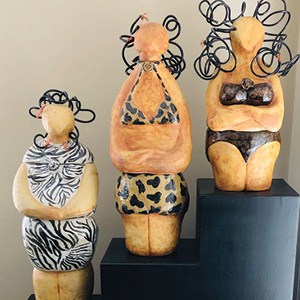
Jodie Frieden - Sculptor
Jodie Frieden
Jodie Frieden, sculptor, a Norfolk native and Virginia Beach resident, is married to Jack and has two daughters.
As illogical as it seems, when I am sculpting I move into another dimension of time and space. It is the medium of clay that grounds me. I love all the feelings that sculpting allows me to experience—the energy and excitement of being inspired, the intensity, as well as the tranquility of creating, and the satisfaction and even the sadness from a work’s completion. My sculptures speak to me and for me, emerging with a passion from my most authentic self.
I’ve been a perpetual student at MOCA for 25 years.

Ivor Kaplan - Painter
Ivor Kaplan
A native of South Africa, long-time resident of Norfolk, and a plastic surgeon, Ivor Kaplan is married to Susan and has three sons. His art takes myriad shapes in various mediums.
This is how I relax. I love trying to change 2D to 3D in any medium that is not limited by need for blood supply (as is a requirement in plastic surgery). Most of my work is Plastikos (from Greek word moldable or malleable, which reshapes flesh and is the basis for plastic surgery.) Portraits were painted several years ago; one is my younger sister, the other is my Dad. I try to paint using strong light and shade “chiaroscuro.”
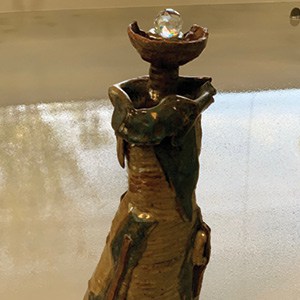
David Cardon - Sculptor
David Cardon
David Cardon, a Tidewater native, lives in Virgina Beach with his wife Elyse and four chuldren. (see page 18).
I love to create a piece of pottery and then use a carving tool to really add character and design. I don’t always have a clear idea when I start a piece where it will end up. The piece with the crystal on top started off as a hand reaching out of the ground on a forearm. As I built it up, I changed my mind and made it more of an abstract standing figure with a neck and a relaxed posture.
10 cyber security smart home tips from Ben-Gurion University
From laptop computers to off-the-shelf devices, the cyber vulnerabilities keep multiplying as homes and offices incorporate more internet-connected devices. According to cyber researchers at Ben-Gurion University of the Negev, it’s always an excellent time to make a few simple changes that will result in a far greater level of safety and security.
“There’s a wide range of steps consumers can easily take, though some require a bit more focus or technical prowess,” says Dr. Yossi Oren, a senior lecturer in BGU’s Department of Software and Information Systems Engineering and head of the Implementation Security and Side-Channel Attacks Lab at Cyber@BGU. “In previous research we found that internet-connected devices such as baby monitors, home security cameras, doorbells, and thermostats were easily hacked by our researchers. Password protection and updated devices are just as important in a smart home as they are on a computer or mobile phone.
BGU’s Tips for Product Security
With the goal of making consumers smarter about smart homes, BGU researchers offer a number of tips to keep families and their IoT devices more secure:
- Never use the same password on multiple websites or online services. Both Apple and Google offer free password managers that can take care of your passwords for you, and even automatically suggest strong passwords that are hard to crack.
- Turn on “two-factor authentication” to prevent hackers who’ve stolen your password from logging into your Facebook or Google account. Two-factor authentication sends a text message with a login code to your phone to verify it’s you.
- On the heels of the recent Facebook hack, in addition to changing your password, use the Facebook settings screen to review the list of apps and websites which you granted access to your data. Remove any apps or websites you don’t recognize and trust.
- Don’t fall prey to clever phishing scams that ask for payment and indicate they have an old password that you recognize. It was likely bought on the illegal “dark web.”
- Do cover your computer camera with tape or use a specially made camera cover to prevent prying eyes.
- Buy IoT devices (cameras, baby monitors, etc.) only from reputable manufacturers and vendors. Change the admin password as soon as you can connect it. Annually check for security updates which you download.
- Avoid used IoT devices like routers or cameras. They could already have malware installed.
- Call your internet service provider and request an updated router. Many are years old and don’t have the latest security updates. Change the WiFi password on your home router.
- Automatically back up your data—pictures, contacts, and documents. If a computer is compromised, it may be easier to just reformat it than to find the malware, and it will allow your devices to function better.
- Evaluate your family’s cyber health. While you yourself may be relatively cyber safe, make sure others in your family, like an elderly parent or teenager, are taking similar precautions.
“In only an hour or two, most of these steps can be accomplished, saving you significant headaches, serious theft and the loss of privacy or priceless data,” Dr. Oren says.
Ready to act? VHDA offers $8K Homeownership Grant for educators and first responders
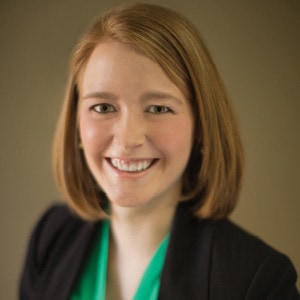
Shikma Rubin
Educators and first responders who want to buy a house in 2019 and would also like to save $8,000 in the process, might consider contacting the Virginia Housing Development Authority (VHDA) about an opportunity.
As of May 2019, the VHDA, a not-for-profit organization that helps Virginians attain quality affordable housing, announced a new grant program on a first-come, first-served basis. Through a partnership with the Federal Home Loan Bank (FHLB) of Atlanta called the Community Heroes Grant Initiative, VHDA plans to distribute 125 individual grants of $8,000 each for a grand total of $1,000,000. These grants will be available to eligible community heroes throughout the Commonwealth who make more money than the guidelines set forth in most down payment assistance programs.
Only first-time homebuyers qualify for the grant. That means the purchaser cannot have owned and occupied a primary residence in the last three years. Buyers must also be a public school educator or first responder as defined in the descriptions below.
Educator: An employee of an accredited or state-recognized or public school; a certified teacher or administrator in an education public school; or an employee of a post-secondary level public educational institution; or has retired as one of the above as may be determined by VHDA at their sole discretion.
First Responder: An employee of a law enforcement agency or the fire department administered by a federal, state, or local government, or sworn law enforcement officer responsible for crime prevention and detection, or criminal incarceration; or a sworn member of a fire department involved in fire suppression or prevention, emergency medical response, hazardous materials incident response, or management/response to terrorism; or any other first responder, such as an emergency medical technician or National Guard or Reservist; or has retired as one of the above as may be determined by VHDA at their sole discretion.
For the $8,000 grant, buyers must meet minimum and maximum household income limits. For example, a household of two in Hampton Roads needs to make $54,201–$81,300 annually. The income limits are based on household size and vary depending on the location of the property being purchased.
In addition, buyers are required to work with a mortgage company that is part of the FHLBank Atlanta member network and is also approved to offer VHDA loan programs. The grant is only applicable for FHA and Fannie Mae conventional loans through VHDA. The borrower must have one percent of the sales price into the transaction from their own funds (or other allowable sources). The grant cannot be combined with other VHDA grants, but in some cases may be combined with other grants.
Finally, the Community Heroes grant is considered a gift and not a lien against the property. That means there’s no requirement to repay the money.
VHDA offers a variety of ways to save money on the purchase of a home. As for the $8,000 Community Heroes grant program, remember it’s on a first-come, first-served basis. For a list of participating lenders, contact VHDA.
Shikma Rubin
Shikma Rubin is a loan officer at Tidewater Home Funding in Chesapeake (NMLS #1114873). She enjoys the chance to lead workshops and webinars on how to buy a home in 2019. She may be reached at srubin@tidewaterhomefunding.com or 757-490-4726.
Israeli Couscous Pilaf: A toasty, fragrant and fresh side dish
 This recipe originally appeared on The Nosher
This recipe originally appeared on The Nosher
Israeli couscous, known in Israel as ptitim, which means “flakes” in Hebrew, is a pearl-shaped, pasta-like product with a delicious toasted wheat flavor. It was invented in Israel’s early years as an inexpensive starch that was more affordable than pricey rice. Nowadays it’s a nostalgic comfort food in the Israeli kitchen, but has also grown in popularity abroad and among chefs in the past 30 years. It’s easily found in the U.S., where it’s marketed as Israeli or pearl couscous.
In this recipe, I’ve paired Israeli couscous with warm spices, fresh mint, currants and toasted pine nuts for a textural, flavorsome dish. It’s an easily adaptable side that’s suited to any occasion.
Make sure to check out the surprising history of Israeli couscous.
RECIPE
Ingredients
- 1¼ cups chicken stock
- ½ teaspoon sea salt
- ¼ teaspoon ground cardamom
- pinch of ground cinnamon
- generous pinch saffron threads
- 1 tablespoon olive oil
- ¼ cup finely chopped yellow onion
- 1 cup Israeli couscous
- 2 tablespoons pine nuts, toasted
- 2 tablespoons currants
- 2 tablespoons finely chopped mint
Directions
- Combine the stock, salt, cardamom, cinnamon and saffron in a small saucepan and bring to a simmer over medium heat.
- Heat the oil in a large saucepan over medium heat. Add the onion and sauté until softened without coloring, about 2 minutes. Add the couscous and cook, stirring, until lightly toasted, about 1 minute.
- Carefully add the stock to the pan and stir to combine. Cover the pan and simmer over medium-low heat until the liquid has been absorbed and the couscous is tender, 8 to 10 minutes. Remove the pan from the heat, remove the lid and fluff the couscous with a fork. Lay a clean dish towel over the pan, without touching the couscous, and place the lid over the towel. Let stand for 5 minutes to allow the towel to absorb the steam.
- Stir in the pine nuts, currants and mint. Serve warm or at room temperature. Serves 3–4 as a side.
Lynda Balslev
Guests stopping by for coffee? Serve this classic marble pound cake recipe.
 This recipe originally appeared on The Nosher.
This recipe originally appeared on The Nosher.
Two defining characteristics of Israeli culture are hospitality and spontaneity. Put those together and you end up with a lot of guests that just pop by for coffee and cake. As a host, you’d typically offer tea or coffee along with some kind of cake or cookie, either homemade or store-bought.
Growing up in Israel, marble pound cake (often store-bought) was a staple in almost every household for just those occasions. The cake usually sat out on the kitchen counter, as family members would casually slice away over the course of a few days.
Traditional pound cake originates from England, but the sweet, dense loaf also has very strong roots in Jewish and Israeli culture. Not so strange, the term for “loaf pan” in Hebrew is actually “English Cake” pan.
In many homes, a simple loaf pound cake is prepared on Thursday night or Friday morning to nosh on after the Friday night meal. Any remnants of the cake are usually eaten as a sweet treat after a Shabbat lunch, when friends often stop by for coffee. A good pound cake recipe can be passed on for generations and is something to really cherish.
This recipe calls for milk for its richness and flavor, so the cake is dairy. If you’d like to make it nondairy, simply substitute soy or almond milk.
RECIPE
Ingredients
- 21⁄3 cups unbleached, all-purpose flour
- 2 teaspoons baking powder
- 1¼ teaspoon kosher salt
- 1½ cups sugar
- 3 large eggs, plus one egg yolk
- 2⁄3 cup whole milk
- ¾ cup grapeseed, avocado or vegetable oil
- 2 teaspoons pure vanilla extract
- ½ teaspoon almond extract
- 3 tablespoons unsweetened cocoa powder
- 1 teaspoon instant coffee
Directions
- Preheat the oven to 350 F. Line a 9-by-5-inch loaf pan with parchment paper and spray with nonstick cooking spray. Set aside.
- In a large bowl, combine the flour, baking powder, salt, and sugar.
- In a medium-sized bowl, combine the eggs, milk, vanilla extract, almond extract, and oil. Whisk to thoroughly combine until becomes light in color, about 2 minutes.
- Make a well in the center of the dry ingredients, and pour the egg and milk mixture into the well. Whisk until thoroughly combined, about 1 or 2 minutes.
- Pour half of the batter into the prepared loaf pan. Add the unsweetened cocoa powder and instant coffee to the remaining batter.
- Whisk to fully incorporate the cocoa powder, removing any lumps.
- Gently pour the chocolate batter over the vanilla batter, and use a skewer or knife to create a marble pattern. Don’t overdo it. You still want to see distinct colors.
- Bake for 50–55 minutes, until a toothpick comes out with moist crumbs.
- Allow the cake to cool completely in the pan before removing.
Leanne Shor

